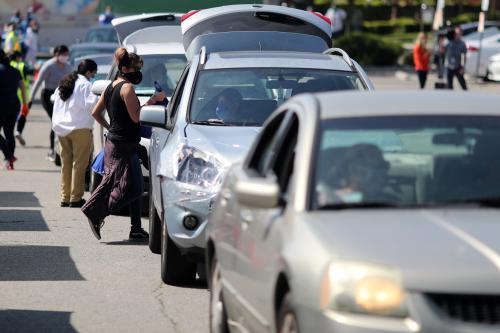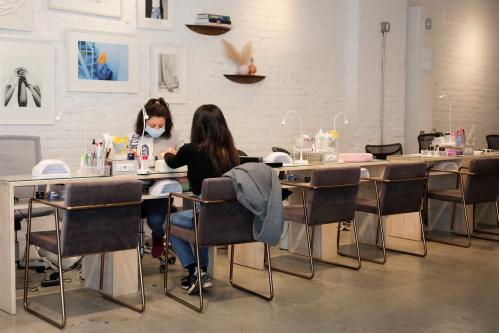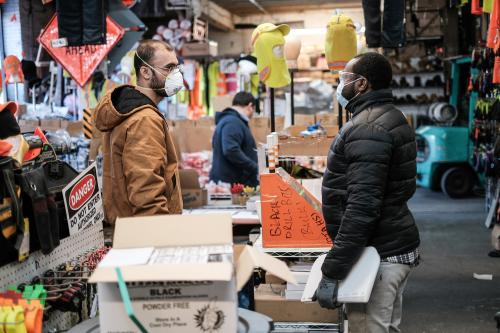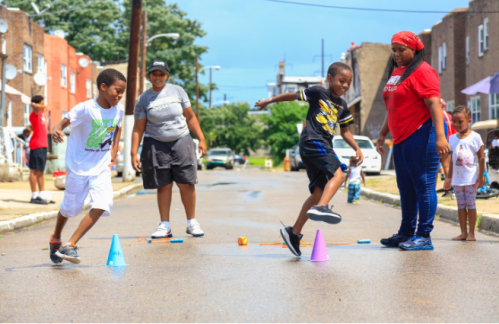The school year may be over, but the pandemic is not. After forcing closures of schools and child care programs—along with much of the economy—COVID-19 cases are rising in a majority of states. This trend does not bode well for the reopening of those programs and schools, which typically welcome students back within the next eight weeks.
Some states are allowing schools to reopen for summer programming, while others have announced there will be at least some in-person instruction in the fall. Child care programs, too, are beginning to reopen. But this crisis has taken its toll. Day care centers are struggling to stay afloat after months of little to no revenue. Many may never reopen, aggravating an already strained child care system. And schools that move toward reopening may not have enough teachers, as some choose not to return to the classroom.
For working parents, the uncertainty surrounding child care and in-person instruction for school-aged children is unprecedented, with a cascading set of consequences on family life, education, and earnings. Moreover, in the event that child care and schools do fully reopen, some parents may not be confident in the safety of those environments and opt to keep their children home.
Even parents who have thus far avoided layoffs and been able to work from home are performing a nearly impossible balancing act every day, keeping up with their own work while caring for and teaching their children. Many others have been laid off, left their jobs to care for their children, or been forced to cobble together temporary child care arrangements as they continue to report for work at essential jobs, such as nursing and grocery work.
Parents with minor children comprise almost one-third of the country’s workforce; any economic recovery will rely on their continued participation or reentry into the labor force. The status of schools and child care programs in the fall will dictate the ability of working parents to fully return to work, and therefore will also largely dictate the speed and robustness of economic recovery.
Millions of working parents rely on school and child care
In 2018, more than 41 million U.S. workers ages 18 to 64 were caring for at least one child under the age of 18. Of these, nearly 34 million have at least one child under the age of 14, and are more likely to rely on school and child care than parents of high school-aged children.

Thirty percent of parents with young children have a caregiver at home—a family adult who is either out of the labor force or working less than half time. The other 70%—or 23.5 million working parents—do not have any potential caregivers, and their return to work will likely be dependent on the reopening of child care programs and schools.

Working parents who rely on child care and school not only comprise a substantial share of the overall U.S. workforce, but also work disproportionately in fields such as education, health care, social assistance, finance, insurance, public administration, management, and professional services. In these industries, at least one in five workers depends on child care and schools.

Several of these industries are friendly to remote work arrangements. As of 2018, more than half of workers in finance, insurance, and management were able to work from home, a rate that has almost certainly increased during the pandemic. Many of these industries have helped keep the U.S. economy afloat while others, such as hospitality and retail, have been forced to lay off millions. Yet this stability may be threatened in coming months if significant numbers of their workers cannot continue to sustainably work from home while also caring for their children into a new school year.
In some regions, school- and child-care-dependent working parents comprise as much as 29% of the workforce
The task of jumpstarting the economy will require millions of Americans to either remain in their current jobs or, for those laid off, to return to the workforce as soon as possible. This could be especially difficult in regions where school- and child-care-dependent working parents make up a high share of the overall workforce.

Workers in the Midwest are particularly likely to depend on child care and school. Of the 16 metro areas where more than 25% of the workforce is school- and child-care-dependent, all but three are in the Midwest.

This is not an issue exclusive to metropolitan areas. Workers in nonmetropolitan regions of South Dakota, Nebraska, Kansas, Iowa, Illinois, Missouri, and Minnesota also rely more on child care and schools than those in other areas of the country.
The Midwest has generally not seen the same breadth of COVID-19 caseloads as the earliest hit cities such as Seattle, San Francisco, and New York, nor is the region yet experiencing the surges happening in Sunbelt states. But what happens over the next few months is difficult to predict, and the decisions the region’s schools and day cares make in the fall will have an especially high impact on the Midwest’s economy.
Continued closures will hit the working poor and mothers especially hard
Other analyses of child-care-dependent workers have suggested that families with multiple workers will be able to have one working adult scale back their hours or quit their job to take on caregiving duties full time, if necessary. But this is unlikely to be feasible for all families, especially those already struggling to make ends meet.
About one in five school- and child-care-dependent working parents lives in a family with income below 200% of the federal poverty line, a standard measure capturing the working poor. This share more than doubles in many regions, particularly metro areas in the Sunbelt—reaching as high as 54% in Sebring, Fla. For these families, having a worker in the family drop out of the labor force to care for children would exacerbate existing financial hardship.

When families do make the decision to have one parent quit their job and remain home, working mothers are predominately the ones who sacrifice their careers and income. This disruption is likely to contribute to earnings gaps and generally depress employment rates among women.
Women are also overrepresented among workers who do not have a potential caregiver in their family. While they comprise 45% of all working parents with young children, women represent 55% of those who depend on child care and schools to be able to work. As the pandemic continues, women will continue to disproportionately face tough decisions between careers and child care.

Reopening decisions are local, but depend on federal support
As the data above shows, millions of working adults rely on school and child care systems to facilitate their participation in the workforce. A full economic recovery simply cannot happen if children do not physically return to schools and child care programs. On the other hand, a full economic recovery is also not possible if COVID-19 cases continue to skyrocket—and there is conflicting information on the potential of schools to spread the virus. This is the needle that education, local, and state leaders must thread.
The decisions around reopening and how best to do it will also be very decentralized, depending on local circumstances at the school district or state level. These decisions will not be easy or risk-free, and the trade-offs involved are numerous and complex. The Centers for Disease Control and Prevention (CDC) and the American Academy of Pediatrics (AAP) have outlined reopening strategies—including physical distancing, keeping students in cohorts, and using face coverings—but also acknowledge that schools, in collaboration with local officials, are responsible for determining the feasibility and implementation of the recommendations.
The risks cannot be eliminated entirely, and must be weighed against other competing concerns. The AAP emphasizes that schools should do whatever they can to reopen in the fall, considering the harm to children who are unable to physically attend classes, especially children with special needs and those without access to digital resources. In an uncertain environment, the reopening process will have to be creative and iterative. As stated by Austin Beutner, superintendent of the Los Angeles Unified School District, it will be a “delicate dance, with a thousand steps, each connected to the other.”
To facilitate this “delicate dance,” schools and child care programs will need additional support from the federal government. The CARES Act directed more than $30 billion to states to address immediate problems in state education budgets. It also infused the Child Care and Development Block Grant (CCDBG) with $3.5 billion to keep child care providers afloat. But still, more aid is needed—in May, a number of education groups asked Congress for an additional $250 billion to improve remote learning, expand nutrition assistance programs, and stabilize school budgets. The U.S. House of Representatives and Senate are considering additional COVID-19 relief packages which include further support for schools and child care, but appear unlikely to fund these systems at the levels needed. With Congress in recess until mid-July, progress on any additional support is on hold.
Furthermore, federal support for schools and child care centers will not be enough where high infection and hospitalization rates necessitate continued closures or part-time in-person instruction. The extension or reimplementation of such closures—even part-time schedules—threatens the livelihoods of working parents who depend on child care.
For the working parents who cannot reliably count on schools and day cares for their children, Congress will need to shore up protections. Elements of the CARES Act specifically support working parents and their families, but many of its most important provisions either expire at the end of July or are unlikely to be adequate as this crisis extends into the fall. Recipients of the increased weekly unemployment benefits will see those benefits expire at the end of the month. Working parents may also find themselves exhausting the 12 weeks of paid parental leave made available through the end of the year. Because of the huge budget shortfalls facing state and local governments, Congress must stand ready to extend and expand support to these working parents, who represent not a niche interest group in the economy, but nearly one in five workers.
In-person school instruction and child care programs, along with strong public health measures to respond quickly to any outbreaks, are the keys to reviving our economy. Congress should not hesitate to provide the level of support needed to safely reopen those systems. But it cannot stop there; future COVID-19 relief should expand support for working parents and their families in regions where health risks make full-time, in-person classes and day care too hazardous. Without that, it’s likely we’ll pick up right where we left at the end of the school year: students learning from home, periodic outbreaks, and sporadic closures. Meanwhile, more and more desperate parents will have to choose between caring for and teaching their children or financially supporting them.
Literature review assistance provided by Caroline George.






